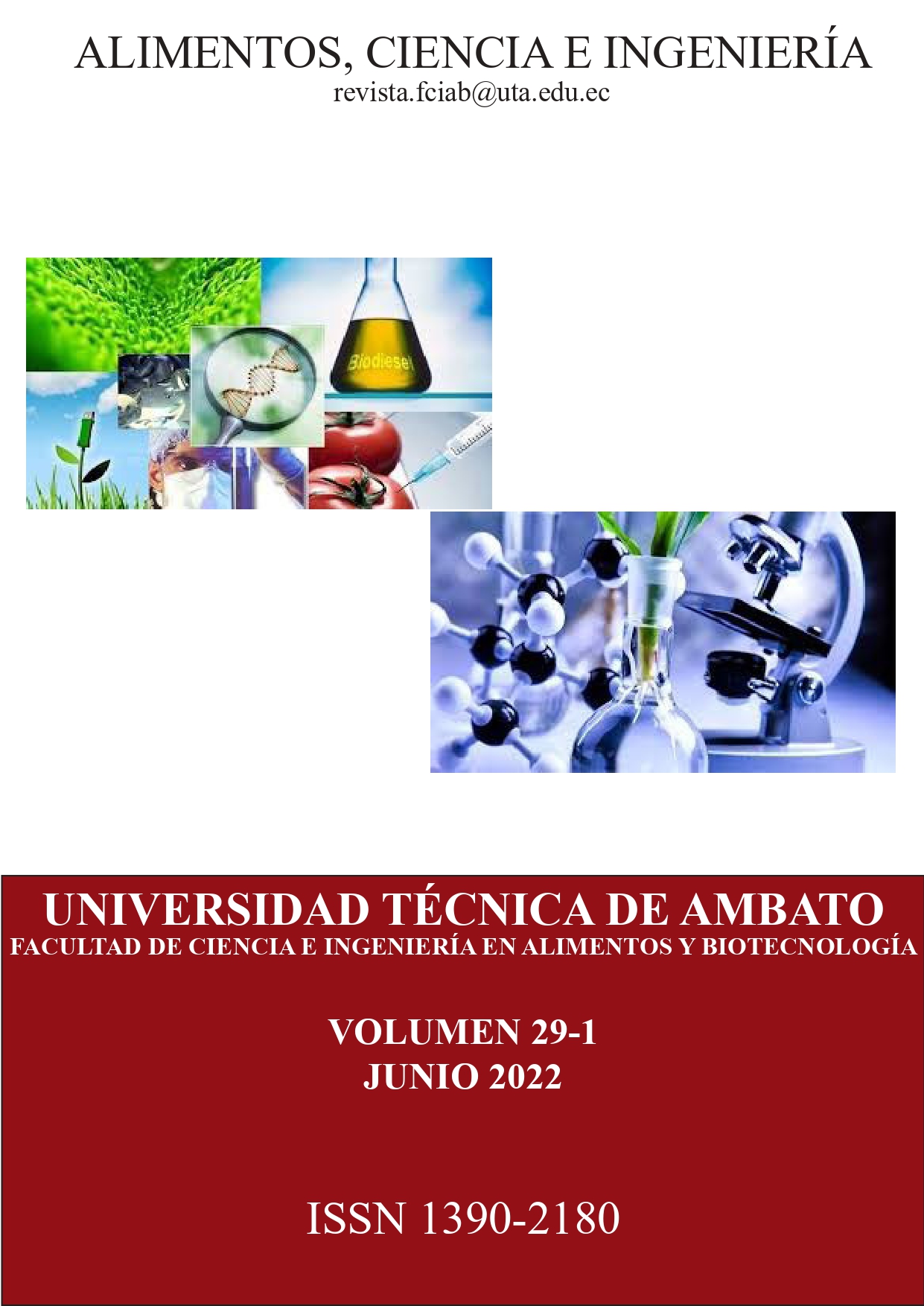Effect of bee honey concentrations on the production of a canned in syrup with pitahayas fruit (Hylocereus undatus) and (Cereus ocampis)
Main Article Content
Abstract
The main objective of the research was to evaluate the effect of three concentrations of honey in the production of a canned in syrup with pitahaya fruit (Hylocereus undatus) and (Cereus ocampis). A Completely Random Design was used with factorial arrangement AxB. For the comparison of averages of the treatments, the TUKEY test was used at (p <0.05) according to the results of the ANOVA (pH and ° Brix), for the sensory analysis a non-parametric statistic was applied using the test of Kruskal Wallis and comparison of means (in cases of statistical significance) using the U Mann-Whitney test. The results of the pH of the pitahaya preserves indicated that there was statistical significance at (p <0.05); obtaining pH values ??in a range from 4.55 to 4.96 and in the final ° Brix there was no statistical significance. The stability of the honey syrup was measured where the treatment A1B1 and A1B3 reached their stability at 28 days obtaining 14.2 and 18.1 ° Brix final. The treatments A1B2, A2B1, A2B2 and A2B3 took 30 days to reach the stability of soluble solids with results of 18.1, 14.7, 18.1 and 22.1 ° Brix. In the organoleptic analysis there was significance at (p <0.05) for the attribute odor and texture, and with respect to flavor, color and appearance it was not significant. The microbiological analyzes performed on the most widely accepted product had acceptable values ??within the parameters stipulated by the INEN 1529 Standard. A favorable effect was obtained with the use of honey in the syrup because it helped to better maintain the pitahaya preserves thanks to its preservative properties.
Downloads
Article Details

This work is licensed under a Creative Commons Attribution-NonCommercial 4.0 International License.
Aquellos autores/as que tengan publicaciones con esta revista, aceptan los términos siguientes:
a. Los autores/as conservarán sus derechos de copiar y redistribuir el material, bajo los términos estipulados en la Licencia de reconocimiento, no comercial que permite a terceros compartir la obra bajo las siguientes condiciones:
Atribución: debe dar el crédito apropiado, proporcionar un enlace a la licencia e indicar si se realizaron cambios. Puede hacerlo de cualquier manera razonable, pero no de ninguna manera que sugiera que el licenciante lo respalda a usted o su uso.
No comercial: no puede utilizar el material con fines comerciales.
Sin restricciones adicionales: no puede aplicar términos legales ni medidas tecnológicas que restrinjan legalmente a otros hacer cualquier cosa que la licencia permita.
References
Adams, M. y Moss, M. (2008). Food Microbiology. Cambridge: The Royal Society of Chemistry.
Álvarez-Suárez, J., Tulipani, S., Díaz, D., Estévez, Y., Romandini, S., Giampieri, F., Damián, E., Astolfi, P., Bompadre, S. y Battino, M. (2010a). “Antioxidant and antimicrobial capacity of several monofloral Cuban honeys and their correlation with color, polyphenol content and other chemical compounds”. Food Chem. Toxicol. 48: 2490-2499.
Álvarez Suárez, J.M., Tulipani, S., Romandini, S., Bertoli, E. y Battino, M. (2010b). “Contribution of honey in nutrition and human health: a review”. Mediterr. J. Nutr. Metab. 3: 15-23.
Antony, S., Rieck, J.R. y Dawson, P.L. (2000). “Effect of dry honey on oxidation in turkey breast meat”. Poultry Science 79: 1846-1850.
Alzamora, S.M., Tapia, M.S. y Welti-Chanes, J. (2004). Nuevas estrategias por procesamiento mínimo de los alimentos: El rol objetivo de la preservación. Ciencia y tecnología de alimentos internacional 4.
Castro, E. (2017). Efecto antibacteriano de miel de Apis mellífera y algarrobina de Prosopis pallida sobre coliformes en quesillos preparados artesanalmente expendidos en el mercado “La Unión”.
Codex Alimentarious. (2001). Norma para la miel de abeja (en línea). Disponible en: http://www.codexalimentarius.net/search/advancedsearch.do
Codex Alimentarius. (2013). Norma para algunas frutas en conserva.
Chen, L., Mehta, A., Berenbaum, M., Zangerl, A.R. y Engeseth, N.J. (2000). “Honeys from different floral sources as inhibitors of enzymatic browning in fruit and vegetable homogenates”. J. Agric. Food Chem. 48: 4997-5000.
Dawson, P.L. y Mathew, S. (2000). “Antioxidative properties of honey in poultry meat”. Summary of a research project funded by the National Honey Board (NHB) and conducted at Clemson University. Available from NHB (www.nhb.org).
FAO. (2007). Buenas prácticas para la producción a pequeña escala de agua de coco embotella: Grados °Brix. Italia. Ro. p 9.
Johnston, J.E., Sepe, H.A., Miano, C.L., Brannan, R.G. y Alderton, A.L. (2005). “Honeys inhibit lipid oxidation in ready-to-eat ground beef patties”. Meat Sci. 70: 627- 631.
McKibben, J. y Engeseth, N.J. (2002). “Honey as a protective agent against lipid oxidation in ground turkey”. J. Agric. Food Chem. 50: 592-595.
Mondragón, P., Rodríguez, R., Renséndiz, J., Ulloa, P., y Ulloa, J. (2010). La miel de abeja y su importancia. Obtenido de https://www.researchgate.net/profile/Rogelio_Rodriguez_Rodriguez/publication/29982 1229_La_miel_de_abeja_y_su_importancia/links/5705c2ff08aef745f717702a/La-miel- de-abeja-y-su-importancia.pdf.
Montesinos, J., Rodríguez, L., Ortiz, R., Fonseca, M., Ruiz, G., & Guevara, F. (2015). Obtenido de INCA: http://scielo.sld.cu/pdf/ctr/v36s1/ctr07s115.pdf.
Murillo, G. (2004). Ficha técnica de industrialización de frutas en conserva. Obtenido de https://es.scribd.com/doc252272651/Ficha-Técnica-de-Industrializacion- de-Frutas-en-Conserva.
Norma INEN 2760. (2013). Norma para conserva de frutas y vegetales. Ecuador.
Oré, L. (2007). Tesis de grado “Evaluación del tratamiento térmico en conserva mixta de papaya (Carica papaya L) y cocona (Solanum topiro) en envases de hojalata”. Universidad Nacional Agraria de la Selva. Perú.
Sotomayor, E. (2018). Tesis de Grado. Desarrollo de mango (Mangifera indica L.) en almíbar a base de miel de abeja y Stevia. Universidad Católica de Santiago de Guayaquil..
Willix, D.J., Molan, P.C. y Harfoot, C.G. (1992). “A comparison of the sensitivity of wound-infecting species of bacteria to the antibacterial activity of manuka honey and other honey”. Journal of Applied Bacteriology 73: 388-39


